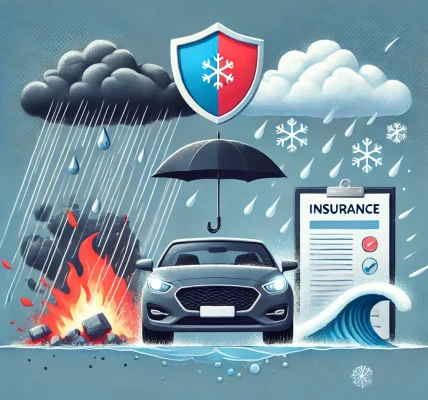As the automotive industry evolves, the debate between electric vehicles (EVs) and gasoline-powered cars (ICEs) continues to gain traction. One key consideration for car buyers is insurance cost, as premiums vary between these two types of vehicles. If you’re trying to decide whether an EV or a gas-powered car is the right choice for you, understanding the differences in insurance expenses can help you make an informed decision.
In this article, we’ll explore the key factors that influence insurance rates for EVs and gas-powered vehicles, the pros and cons of each, and tips to get the best insurance deal.
Why Insurance Costs Differ Between Electric and Gas Cars
Insurance premiums are calculated based on various factors, including vehicle value, repair costs, safety ratings, theft risk, and claims history. Since electric and gas cars have distinct characteristics, their insurance costs reflect these differences.
1. Vehicle Cost and Market Value
- EVs generally cost more than their gas counterparts due to advanced battery technology, research, and limited production compared to traditional cars.
- Since insurance premiums are partially based on the replacement cost of the vehicle, a higher market value translates to higher insurance premiums for EVs.
- Example: A Tesla Model 3 has a higher insurance premium than a similarly priced gas-powered sedan because of its battery replacement cost and specialized repairs.
2. Repair and Maintenance Costs
- Electric cars require specialized repairs, often at certified service centers. EV components like batteries, electric drivetrains, and software require trained technicians, increasing labor costs.
- Gasoline cars have a well-established repair industry, making maintenance and repair costs lower and more accessible.
- Since insurance companies consider repair expenses when determining premiums, EVs tend to have higher premiums due to costly repairs.
3. Safety Features and Crash Risks
- EVs often come with advanced driver-assistance systems (ADAS) such as automatic emergency braking, lane departure warnings, and collision avoidance, which reduce accident risks.
- On the other hand, gas-powered vehicles vary in terms of safety features, depending on the make and model.
- Some insurers offer discounts on EV insurance due to these enhanced safety features, but overall premiums may still be higher due to repair costs.
4. Battery Replacement and Fire Risks
- One of the main concerns with EV insurance costs is battery replacement. EV batteries can cost anywhere from $5,000 to $15,000, making accidents involving battery damage significantly more expensive.
- Additionally, although rare, battery fires in EVs take longer to extinguish, leading to higher claim payouts.
- Gas-powered cars also have fire risks, but the cost of repair is generally lower.
5. Availability of Parts and Mechanics
- Since EV parts are not as widely available as gasoline car components, it may take longer to repair an electric car, increasing the overall claim cost for insurers.
- Gas-powered vehicles have an established supply chain, reducing wait times for parts and repairs.
Which One is Cheaper to Insure? EVs or Gas Cars?
While EVs typically have higher insurance premiums, some factors can reduce their insurance costs:
✅ Situations Where EVs May Have Lower Insurance Costs:
- Government incentives & tax credits: Some insurers provide discounts for eco-friendly vehicles.
- Lower accident rates: EVs often have better crash test ratings and fewer moving parts that could fail.
- Mileage-based discounts: Since EV owners tend to drive fewer miles on average, insurers may offer lower-mileage discounts.
❌ Situations Where Gas Cars May Be Cheaper to Insure:
- Lower repair costs & easy availability of mechanics.
- Lower vehicle value and replacement costs.
- Wider insurance options & more competition among insurers.
How to Lower Insurance Costs for Both EVs and Gas Cars
Whether you drive an electric or gas-powered car, you can take steps to reduce your insurance premiums:
✅ 1. Compare Insurance Quotes
- Different insurers weigh factors differently, so it’s always a good idea to compare multiple quotes before purchasing a policy.
✅ 2. Increase Your Deductible
- Choosing a higher deductible can significantly lower your monthly premium. Just ensure you have enough savings to cover the deductible in case of an accident.
✅ 3. Look for Green Car Discounts
- Many insurance companies offer discounts for EV owners as an incentive to promote eco-friendly vehicles.
✅ 4. Bundle Your Insurance Policies
- If you have multiple vehicles, home insurance, or renters insurance, bundling them with one provider can lead to substantial savings.
✅ 5. Maintain a Good Driving Record
- A clean driving record can lower premiums by 10-30% over time, whether you drive an EV or a gas-powered car.
Final Verdict: Which is More Affordable in the Long Run?
When it comes to insurance costs, gas-powered cars still have an edge due to their lower repair costs, established infrastructure, and wider insurance options. However, as EVs become more mainstream, their insurance premiums are expected to decrease.
Key Takeaways:
🚗 EVs typically have higher insurance premiums due to expensive repairs, battery costs, and specialized mechanics.
⛽ Gas cars are generally cheaper to insure, but may not have the same advanced safety features as EVs.
💰 You can reduce insurance costs for both by choosing higher deductibles, bundling policies, and maintaining a clean driving record.
If you’re looking for long-term savings, EVs may still be the better option due to lower fuel costs, government incentives, and lower maintenance expenses. However, if low insurance premiums are your top priority, a gasoline-powered car might be the more affordable choice today.
Considering switching to an EV or looking for the best insurance rates? Compare quotes from different insurers to find the most budget-friendly policy that suits your needs!



